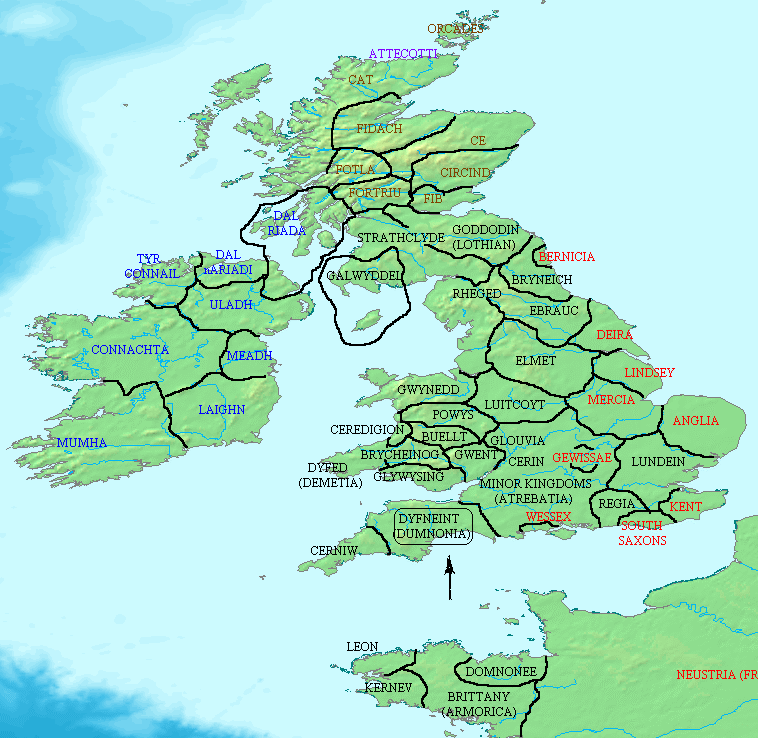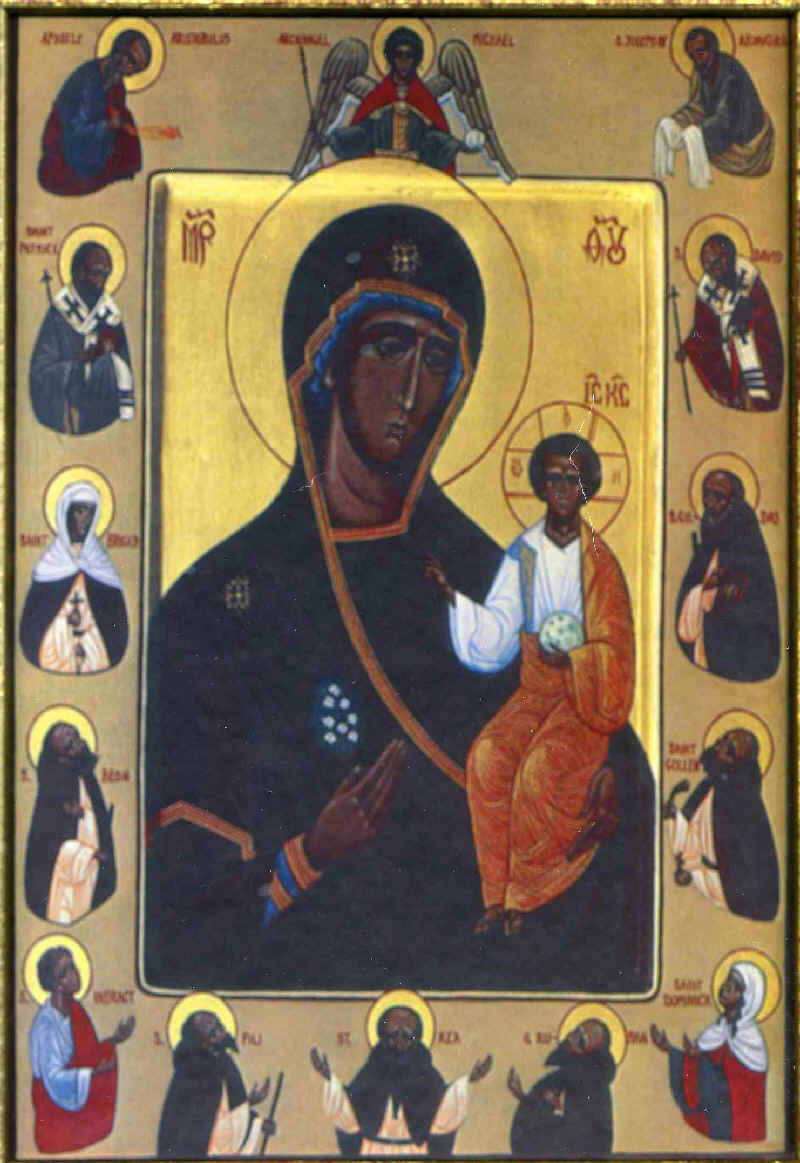
The original icon
(above)
of Our Lady of Glastonbury hangs in the Chapel of Saint
Simeon & Saint Anna, Combe Martin. It was painted by Fr
David (of blessed memory) founder of the Orthodox
Brotherhood of Saint Seraphim at Walsingham. It depicts
the Mother of God and Her Son. Christ holds the universe
and the Holy Thorn. Also represented are the Archangel
Michael, Saint Aristobulos, Saint Joseph of Arimathaea,
Saint Patrick, Saint Brigid, Saint Beon, Saint Indracht,
Saint Fili, Saint Kea, Saint Ruman, Saint Domenica,
Saint Collen, Saint Gildas and Saint David, all of whom
traditionally have associations with Glastonbury.
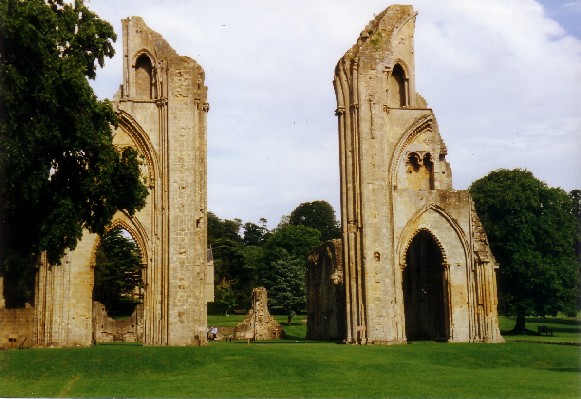
Ruins of Glastonbury Abbey (early 6th century
A.D.)
Saint Rumon - 5th January
According to
Glastonbury's list of relics Rumon was a son of the King
of Brittany. He was born in the early sixth century and
probably studied the Scriptures in Ireland, returning to
Britain with St Breaca.
Although he is the patron
saint of Tavistock and was a companion of Sts Fili and
Kea and features with them on our Glastonbury icon, the
stories of his life have him in Brittany. There he built
a hermitage and local peasants and grandees alike sought
his advice. When he died his body was originally buried
in Brittany. According to Sabine Baring-Gould his relics
were brought to Britain for safety during the Viking
raids in the early tenth century. In 960 they were
brought to the newly founded Tavistock Abbey and there
they worked miracles until the monastery was dissolved
by Henry VIII.

Tavistock Abbey (founded in 960 AD -
plundered and burnt by the Danes in 997 AD)
Saint Gildas - 29th
January
St Gildas came from the
Clyde area, son of the northern King Caw. He was
educated in the south then returned home to do
missionary work, which later took him to Wales. Not only
was he a monk but also a historian - mostly remembered
for his work 'De Excidio Britannae'.
Some stories associate
Gildas and his family with King Arthur, with whom there
was a long-standing feud, which was finally settled with
the help of St Cadog.
St Gildas lived much of
his life as a hermit, for a while on the island of
Flatholm in the Bristol Channel and finally in Street,
then known as Llantokey, where he died on 29th January
570 and was buried in Glastonbury Abbey.
Saint
Brigid
- 1st February
St Brigid was born in
Ireland in 452 to a Christian mother who was a slave of
her father, the pagan chieftain of Leinster. Brigid
suffered hardships as a child but she remained cheerful
and was kind both to people and to animals.
Like her mother she
worked for her father in the kitchen and dairy and gave
away food to the poor. When her father protested she
replied, "Christ dwelt in every creature". He tried
unsuccessfully to sell her to the King of Leinster and
eventually gave her freedom.
Brigid refused good
offers of marriage and instead founded the first women's
monastery in Ireland at Kildare, so called because it
was under a giant oak tree and was known as the 'church
of the oak', or Cill Dara. This monastery became a
centre of religion and learning. Brigid also founded a
school of art, which became famous for illuminated
manuscripts, as well as continuing to help the poor and
the sick.
Whilst comforting a dying
pagan with stories of Christ, she unwittingly wove a
cross from the rushes that covered the floor. This
simple rush cross known as St Brigid's Cross is still
made in Ireland and placed in the rafters of houses on
her feast day.
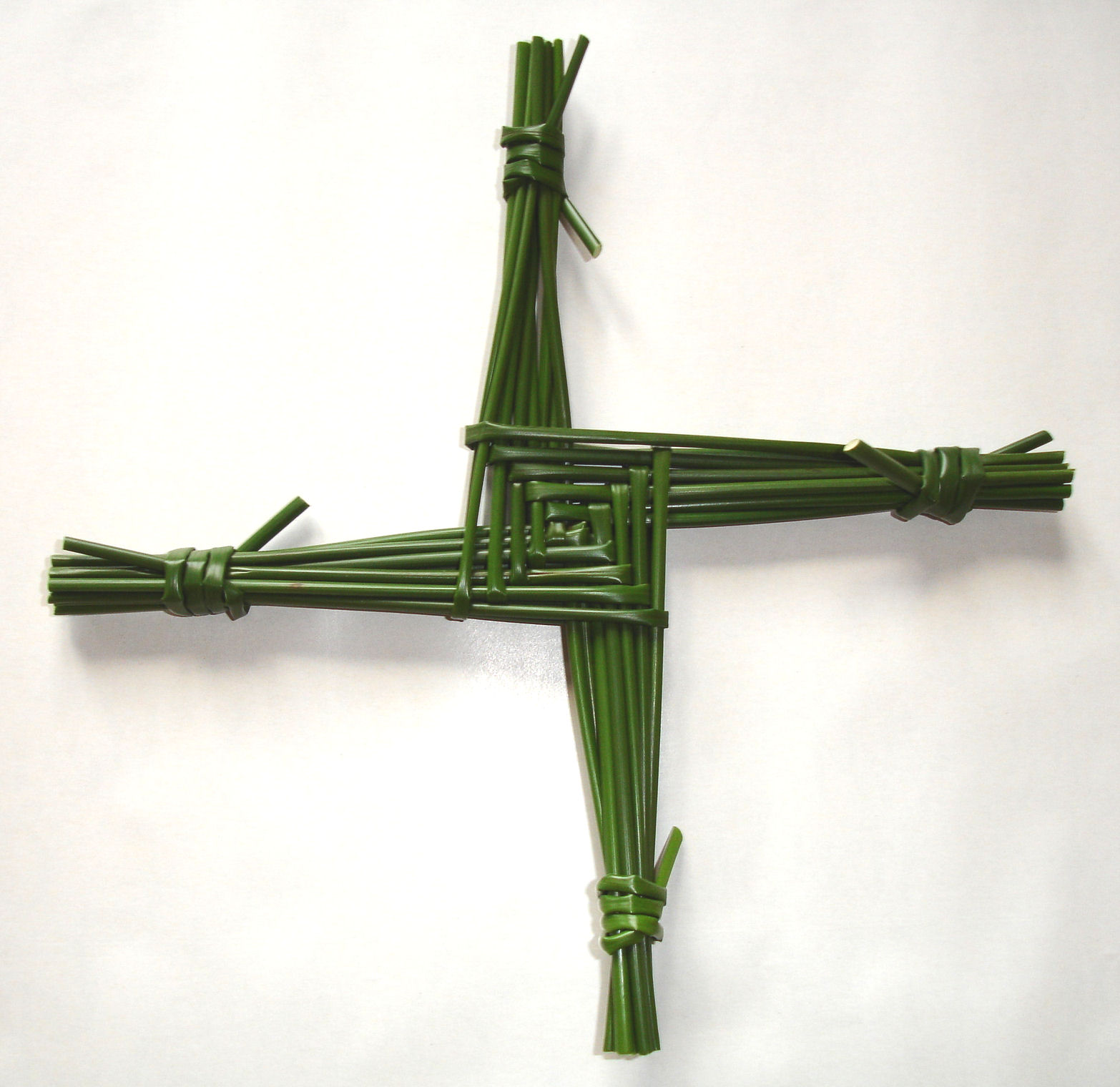
According to the Book of
Lismore, St Brigid was 'abstinent, she was innocent, she
was prayerful, she was patient; she was glad in God's
commandments; she was firm, she was loving; she was a
consecrated casket for keeping Christ's Body and His
Blood; she was a temple of God, her heart and mind were
a throne of rest for the Holy Spirit.'
Brigid died on 1st
February 525 in Kildare. Bridestowe parish
church, near Okehampton is dedicated to St Brigid.
Saint Ia - 3rd February
St Ia was born in Ireland
in the fifth century and later came to Cornwall. She
should have come with St Fingar and his companions but
they set off without her. Obviously her mission to
Cornwall was pleasing to God because miraculously a
large leaf appeared to take St Ia on her journey, and
although she left after St Fingar's party she arrived
before them. She spent many years doing Christ's work
before she was martyred along with other missionaries.
Saint Piran - 5th March
St Piran is another fifth
century saint of Irish heritage. He spent his youth in
South Wales where he became friends with St Finnian and
the two men returned to Ireland together.
As an old man in Ireland,
St Piran was captured by local pagans who were jealous
of his power to heal. They put a millstone round his
neck and threw him off the cliffs into a raging sea. As
soon as he hit the water the seas calmed and the
millstone became like a cork, which he used as a raft
and set sail for Cornwall. He landed at Perran Beath and
built an oratory at St Piran-in-the-Sand.
According to Geoffrey of
Monmouth St Piran became chaplain to King Arthur at
Tintagel.
St Piran became popular
in Cornwall because he provided the people with a
profitable living. Having made a fireplace from a large
lump of black rock, he noted that as the flames grew hot
a trickle of pure white metal (tin)oozed from it. This white
trickle on a black rock is symbolized in the Cornish
flag: a white cross on a black background.
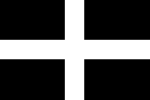
Saint Petroc - 4th June
St Petroc was the son of
a Welsh king, but he refused to succeed his father.
Instead he and his retainers became monks. He spent some
time in Ireland before going to Cornwall. He landed in
the Camel estuary with a group of companions (Sts
Croidan, Medan and Degan whose memories we also keep
today) and travelled to Padstow. On the way he met some
men working in the fields and asked them what their
religion was. Not being a couth bunch and wanting to
test Petroc's holiness they said they were thirsty and
asked if he could make a rock produce water. Petroc hit
the rock with his stick and out came pure fresh water,
and this spring has never dried up.
Petroc lived in Cornwall
for thirty years, founding a monastery in Bodmin where
he observed a strict and severe rule - spending nights
in cold rivers and eating a very meagre diet of bread
and on Sundays, because it is the day of the
Resurrection, a few pulses. He was a great lover of
animals and his saving a stag from huntsmen led to King
Constantine of Cornwall being converted to Christianity,
and later dying as a martyr.
St Petroc was also a
great traveller. He went on a pilgrimage to Rome and
then to Jerusalem. From there he set out for the East,
to India and beyond before returning to Cornwall seven
years later.
On 4th June 564 Petroc
succumbed to the rigours of his ascetic life and
constant missionary work and his body was interred at
Bodmin. But Petroc's travels didn't stop there. After
the feast of the Epiphany in 1177 a Breton priest stole
the body and took it back to Brittany as a gift for the
Abbey of St Meen. The prior of Bodmin appealed to Henry
II who ruled Brittany at that time and the monks of St
Meen relinquished the relics and they were returned to
Bodmin in an ivory casket, which itself was stolen only
a few years ago.
Saint Nectan
-17th June
St Nectan was born in
468, the eldest son of a Welsh king, and had twenty-four
brothers and twenty-four sisters. He was inspired by the
life of St Anthony of Egypt and became a hermit. He left
Wales intending to live wherever his boat landed, which
was at Hartland Point. At nearby Stoke he built a church
and a hermitage and lived a solitary life, except for
his brothers' and sisters' annual visit after Christmas.
In 510 Nectan was given
two cows by a swineherd for helping find his lost pigs.
On 17th June that year two robbers stole the cattle, but
Nectan tracked them down and tried to convert them. In
their turn the thieves cut off Nectan's head. Nectan
picked up his head and went home. It is said the dark
pink foxgloves that line the verges in June grow where
drops of his blood fell. Back in Stoke he laid his head
upon a rock by a well and died.
Saint Brannoc - 26th June
(in
Braunton & North Devon, 7th January elsewhere)
St Brannoc lived in the
sixth century and was tutor to the children of King
Brychan of Wales. He left Wales for several years, first
travelling as a pilgrim with the king to the Tomb of the
Apostles, then spending some years in Brittany where he
founded many churches.
He is said to have come
to North Devon floating on a stone coffin and first
settled in a cave in Mortehoe. He built his first church
in the area where St Brannoc's Well is now, but it fell
down. In a vision he was told to build a church where he
found a sow and five piglets, and he found them in the
village of Braunton. Having settled in Braunton he
spent his life teaching holiness and husbandry.
Saint Urith - 8th July
St Urith lived in the 7th
century. She was born in East Stowford, near Barnstaple
and converted to Christianity by St Kea. She lived as a
hermit in nearby Chittlehampton, where she founded a
church. At the behest of a jealous, and pagan,
stepmother some female haymakers killed Urith with a
scythe. The moment she fell to the ground and died a
spring appeared at that place. She was buried in the
church she founded.
From that moment her
shrine became a popular place of pilgrimage -
Chittlehampton church owes its tower to the pilgrims'
donations. As with so many of the country's other sacred
sites, her shrine was removed during the Reformation and
veneration of her relics forbidden.
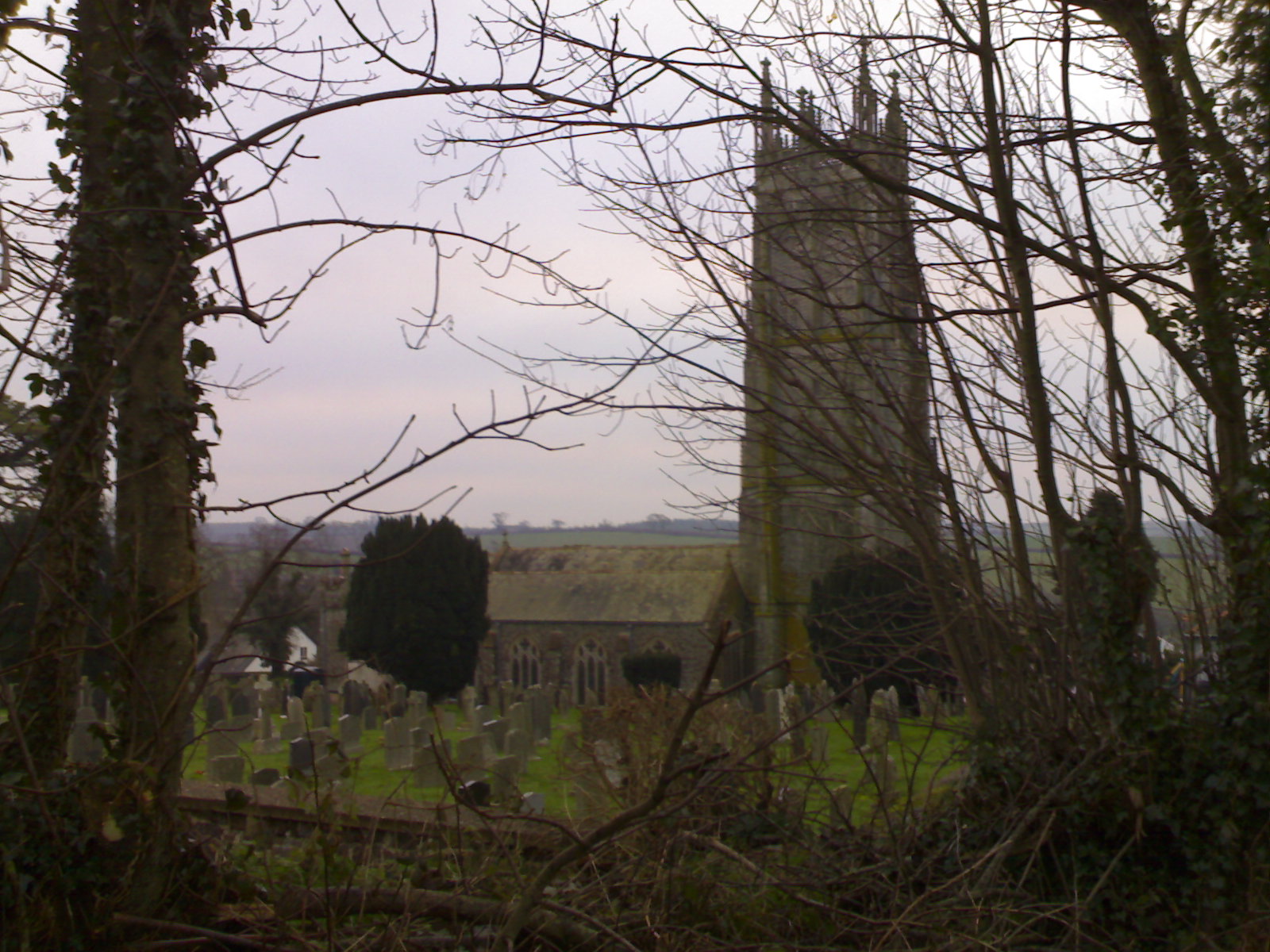
Chittlehampton Church - near Devon
Saint Sidwell - 2nd
August
In the county of Devon,
in a city called Exeter after the river that flows
through it, there lived a man of noble birth and virtue
by the name of Beorna. He had one son and four daughters
- one of whom was recognised to be of great goodwill in
the Lord; her name was Sidwell. Nature and grace so
worked together in her that they conferred on her a
title of praise for beauty of form and moral integrity.
But since the good are often persecuted by the jealous,
and traps are sometimes laid for those having good
fortune, after the funeral of her mother she was soon
falsely ensnared by a stepmother's hostility.
Thus, Sidwell was
persuaded by a stepmother consumed with greed to go out
through the city streets and beyond into the fields of
which this schemer planned to rob her, harbouring in her
breast a wicked plot to murder the holy girl. And so one
day the serfs mowing meadows outside the city walls were
induced by her to undertake a deadly attack on the
virgin the following day, when she would come by herself
to bring them food. Seduced by the hope of reward, the
serfs agreed, promising to carry out the woman's
instructions.
Next day the virgin, holy
and guiltless, carrying down the food by herself to the
meadows that were being mown, was sent by her stepmother
to execution. As the virgin came near, these most wicked
serfs drove their scythes through the neck of the
innocent one. While approaching however, she had
forebodings of her death; she calmly handed them their
food and fortified herself with prayer. Her head cut
off, she rendered back her spirit to her Creator.
Now the Divine Mercy,
which distributes gifts of different kinds, not
hesitating to make manifest the purity of virginal
innocence caused the clearest of springs to well up in
the place where the virgin's blood spattered. Seeing
this, the butchers wanted to conceal the villainy they
had perpetrated; and although unable to cover the spring
with grass, they tried to hide the body. But lest
through their silence she should be robbed of her title
to sanctity, the city watchmen on their nightly rounds
saw a brilliant shaft of light from out of heaven
shining over the virgin's body. This they saw for three
nights; and on the fourth night following, to their
dread, they saw the body of the virgin herself,
surrounded by a radiance, carrying her severed head in
her hands, from the place of her martyrdom to the place
where the faithful Christian community subsequently
built the virgin's church. Here in the morning, prompted
by the heaven-sent sign, the people came in haste and
found the virgin's head, not rolled elsewhere but joined
to the body, just as if it had been placed there by the
care of the faithful. So she was buried in that very
place, Christ's martyr Sidwell, by whose merit into our
own times, the lame walk, the blind see, and a multitude
sick with various diseases find healing and perfect
health.
(From Legenda Sanctorum
by Bishop John Grandisson of Exeter 14th Century)
St Winifred -
November
St Winifred, St Gwenfrewy
in Welsh, was the daughter of a rich Welsh Lord. Wishing
to escape the attentions of some young princes, she
moved away with her uncle, St Beuno, to Abeluyc.
One day when Winifred was
left alone in the house whilst everyone else had gone to
church, King Caradog stopped at the house. He was very
taken with Winifred's beauty, but she was not taken with
his advances and rejected him, whereupon he tried to use
force. Winifred fled to towards the church and the
furious Caradog chased her. On the steps of the church
Caradog cut off her head. Immediately, a spring of pure,
clear water appeared where her head fell.
St Beuno rushed from the
church and taking her head he set it back in its place.
Then he and the congregation prayed that she would be
restored to life. Their prayers were answered.
In thanksgiving, Winifred
decided to devote her life to Christ, first staying in
the church at Abeluyc with eleven maidens to whom she
gave religious instruction.
After a pilgrimage to
Rome she called the holy men and women of Wales to the
'Synod of Winifred', where it was agreed that living a
religious life in a group was preferable to the life of
a hermit. Creating new establishments similar to the one
at Abeluyc was not easy for Winifred as not all the
hermits were interested in these new-fangled ideas.
Eventually she met St Tenoi, mother of St Eleri, and
they set up a monastery in the village of Gwtherin.
Winifred eventually became its abbess and when she died
on 3rd November 660 she was buried in the cemetery
there. In 1136 her relics were moved to Shrewsbury Abbey
where a splendid shrine was created.
St Winifred is not a
Devon or Cornish saint, but Manaton church is dedicated
to her and Culbone church also has a connection with the
saint.
This
tiny church (35 foot long) is situated in a steep wooded
valley near Porlock and can only be reached by foot.
The name Culbone is
thought to come from 'Kil Beun' meaning Church of St
Beuno, St Winifred's uncle, born in 550. He died in 642
and his feast day is 21st April.
Saint Kea - 5th November
St Kea was possibly of
Cornish descent and came as monk from Glastonbury to
preach to our part of the West Country and would have
been a companion of Sts Fili and Rumon.
Kea must have spent some
time in Ireland as one story says he came to Cornwall
from Ireland floating on a stone. He had been so upset
when he was left behind by fellow monks that as he
prayed he fainted. When he came round the hollow stone
he had been kneeling on was afloat. After many days
drifting through storms he arrived at Churchtown Creek
on the River Fal.
*******************************************************************************
Location of Dumnonia -
6th century Britain
